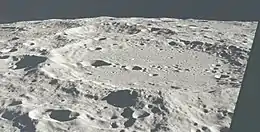Pavlov (crater)
Pavlov is a lunar impact crater on the far side of the Moon, approximately 143 kilometers in diameter.[1] Located just to the north-northeast of it is the crater Levi-Civita while to the southeast is Jules Verne.
 Oblique Lunar Orbiter 2 image, facing south | |
| Coordinates | 28.8°S 142.5°E |
|---|---|
| Diameter | 143.05 km |
| Colongitude | 220° at sunrise |
| Eponym | Ivan P. Pavlov |
Description
The outer rim of Pavlov is somewhat worn and has been damaged in a few locations. There are outward bulges along the southern and eastern rim, and smaller bulges along the western side. Several small craters lie along the inner walls and the interior floor. Pavlov H is located along the east-southeastern edge of the floor. There is a small crater chain leading to the northwest of this satellite, culminating in a teardrop-shaped crater to the east of the midpoint of Pavlov. There are also small, cup-shaped craters along the southeastern and northwestern edges of the floor. Where it is not marked by tiny craters, the interior floor of Pavlov is relatively flat and level.
Satellite craters

By convention these features are identified on lunar maps by placing the letter on the side of the crater midpoint that is closest to Pavlov.
| Pavlov | Latitude | Longitude | Diameter | Ref |
|---|---|---|---|---|
| G | 29.1° S | 145.4° E | 43.92 km | WGPSN |
| H | 28.6° S | 143.5° E | 17.31 km | WGPSN |
| M | 32.3° S | 141.8° E | 60.64 km | WGPSN |
| P | 33.7° S | 139.5° E | 50.1 km | WGPSN |
| T | 28.0° S | 138.0° E | 52.36 km | WGPSN |
| V | 26.7° S | 138.0° E | 54.82 km | WGPSN |
See also
- 1007 Pawlowia, asteroid
References
- "Pavlov (crater)". Gazetteer of Planetary Nomenclature. USGS Astrogeology Research Program.
- Andersson, L. E.; Whitaker, E. A. (1982). NASA Catalogue of Lunar Nomenclature. NASA RP-1097.CS1 maint: ref=harv (link)
- Blue, Jennifer (July 25, 2007). "Gazetteer of Planetary Nomenclature". USGS. Retrieved 2007-08-05.CS1 maint: ref=harv (link)
- Bussey, B.; Spudis, P. (2004). The Clementine Atlas of the Moon. New York: Cambridge University Press. ISBN 978-0-521-81528-4.CS1 maint: ref=harv (link)
- Cocks, Elijah E.; Cocks, Josiah C. (1995). Who's Who on the Moon: A Biographical Dictionary of Lunar Nomenclature. Tudor Publishers. ISBN 978-0-936389-27-1.CS1 maint: ref=harv (link)
- McDowell, Jonathan (July 15, 2007). "Lunar Nomenclature". Jonathan's Space Report. Retrieved 2007-10-24.CS1 maint: ref=harv (link)
- Menzel, D. H.; Minnaert, M.; Levin, B.; Dollfus, A.; Bell, B. (1971). "Report on Lunar Nomenclature by the Working Group of Commission 17 of the IAU". Space Science Reviews. 12 (2): 136–186. Bibcode:1971SSRv...12..136M. doi:10.1007/BF00171763.CS1 maint: ref=harv (link)
- Moore, Patrick (2001). On the Moon. Sterling Publishing Co. ISBN 978-0-304-35469-6.CS1 maint: ref=harv (link)
- Price, Fred W. (1988). The Moon Observer's Handbook. Cambridge University Press. ISBN 978-0-521-33500-3.CS1 maint: ref=harv (link)
- Rükl, Antonín (1990). Atlas of the Moon. Kalmbach Books. ISBN 978-0-913135-17-4.CS1 maint: ref=harv (link)
- Webb, Rev. T. W. (1962). Celestial Objects for Common Telescopes (6th revised ed.). Dover. ISBN 978-0-486-20917-3.CS1 maint: ref=harv (link)
- Whitaker, Ewen A. (1999). Mapping and Naming the Moon. Cambridge University Press. ISBN 978-0-521-62248-6.CS1 maint: ref=harv (link)
- Wlasuk, Peter T. (2000). Observing the Moon. Springer. ISBN 978-1-85233-193-1.CS1 maint: ref=harv (link)